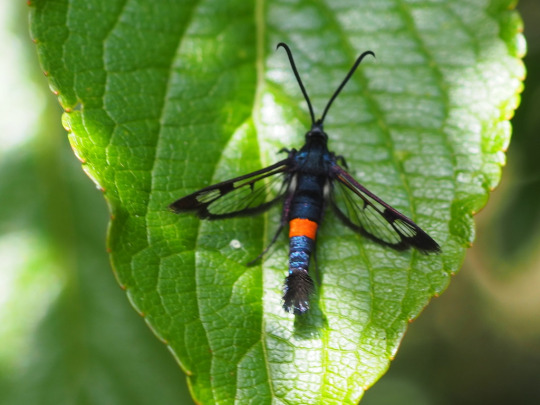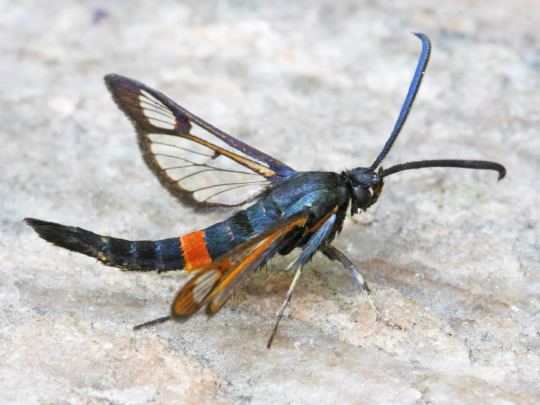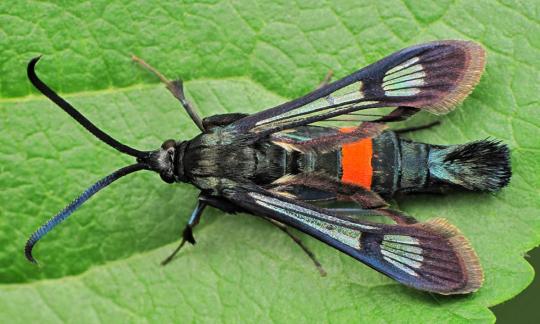#Synanthedon myopaeformis
Explore tagged Tumblr posts
Text
Moth Of The Day #292
Red-belted Clearwing / Aplle Clearwing Moth
Synanthedon myopaeformis
From the sesiidae family. They have a wingspan of 18-28 mm. They are native to Europe, the Near East and North Africa, though has also been introduced to North America.


Image sources: [1] [2]
#moth#moths#lepidopterology#lepidoptera#nature#pretty moth#bugs#insect#moth of the day#motd#lepidoptery#entomology#bugblr#invertebrates#insects#bug#red belted clearwing#red-belted clearwing#apple clearwing moth#synanthedon myopaeformis#sesiidae#sesiidae moth
236 notes
·
View notes
Text
Moth of the Week
Red-Belted Clearwing
Synanthedon myopaeformis

Image Source
The red-belted clearwing is a part of the family Sesiidae. It was first described in 1789 by Moritz Balthasar Borkhausen as Sphinx myopaeformis. This was later changed to Synanthedon myopaeformis. This moth is called the red-belted clearwing in Europe, the apple clearwing moth in North America, and the apple borer. This is due to their tendency to damage their host apple trees. It is considered a pest in Europe.
They may be confused with the large red-belted clearwing and the red-tipped clearwing.
Description This moth has a thin, dark blue, segmented body. The body is hairless aside from a bushy tail at the end of the abdomen. They are noticeable due to a bright red-orange band on one of the segments of the abdomen. The wings are clear with a dark outline and veins and a fringe on the outer margin (outer edge). The wings help distinguish the red-belted clearwing from the large red-belted and red-tipped clearwings as the wings have no red-orange markings.
Wingspan Range: 1.8 - 2.8 cm (≈0.71 - 1.1 in)
Diet and Habitat This species eats mainly apple, specifically Crab Apple (Malus sylvestris), as well as Pear (Pryus communis), Hawthorn (Crateagus monogyna), Almond (Prunus dulcis), Rowan (Sorbus aucuparia), apricots, cherries, mountain ash, peaches, plums, and quince. In Canada, adult moths have been attracted to the flowers of the snowy milkweed.
They can be found natively in Europe, North Africa, and Asia Minor. This species was noticed to North America and first detected in Canada in 2005. They inhabit well established orchards and gardens, hedgerows, open woodland, and mature scrub.
Mating Adults emerge from their cocoons in early summer and on flight from May to August, this is presumably their mating season. Females can lay up to 250 eggs, usually singly in the cracks or damaged areas of the trunk and branches they are hosting in. Females attract males with pheromones released from glands. A 2010 study found that 3,13-octadecadienyl acetate is the primary sex hormone.
Predators The larvae of this moth are preyed on by parasites, fungi, and bacteria. The main parasite of red-belted clearwing larvae is Liotryphan crassiseta. Other parasites are Nematodes, Steinernema sp. The fungi Beauveria bassiana and Metarhizium brunneum are common causes of death in larvae as well as the bacteria Bacillus thuringiensis.
Fun Fact
The adult red-belted clearwings are significantly less active on cold days compared to warm days.
In 2014, Judd and Eby found that S. myopaeformis does not discriminate between yellow, green and white or between purple, blue, red, and black. This suggests that they are dichromatic, meaning they can perceive mainly two colors. This affected traps set to catch this species as they acted differently depending on the light reflected.
As this species is considered a pest to apple trees, people have attempted to control the population. This has been tried with pheromone/mating disruption, pheromone laced traps, other chemical traps, the use of predators/enemies, and the covering of apple tree trunks in oil.
(Source: Wikipedia [1][2][3], Butterfly Conservation, Michigan State University)
#libraryofmoths#animals#bugs#facts#insects#moth#lepidoptera#mothoftheweek#sesiidae#red-belted clearwing#Synanthedon myopaeformis#apple clearwing#apple borer#very late post#sorry for the absence
55 notes
·
View notes
Text









🐝
𝗔𝘀𝗰𝗹𝗲𝗽𝗶𝗮𝘀 𝘀𝗽𝗲𝗰𝗶𝗼𝘀𝗮 is a milky-sapped perennial plant in the dogbane family (Apocynaceae), known commonly as the 𝘀𝗵𝗼𝘄𝘆 𝗺𝗶𝗹𝗸𝘄𝗲𝗲𝗱, and is found in the Western half of North America.
The eye-catching, hirsute, pale pink through pinkish-purple flowers occur in dense umbellate cymes. Their corollas are reflexed and the central flower parts, five hoods with prominent hooks, form a star shape.
The fruit is a large, rough follicle filled with many flat oval seeds, each with silky hairs.
This species flowers from May through September.
Native Americans used fiber in the stems for rope, basketry, and nets. Some Native Americans believed the milky sap had medicinal qualities, however, most species of milkweed are toxic, particularly to livestock.
The young leaves and seed pods can be boiled and eaten.
Asclepias speciosa is a specific monarch butterfly food and habitat plant. Additionally, phenylacetaldehyde produced by the plants attracts Synanthedon myopaeformis, the red-belted clearwing moth. It is also a larval host for the dogbane tiger moth and the queen butterfly.
🦋
𝘽𝙤𝙣𝙪𝙨
𝗘𝗽𝗮𝗿𝗴𝘆𝗿𝗲𝘂𝘀 𝗰𝗹𝗮𝗿𝘂𝘀, the 𝙨𝙞𝙡𝙫𝙚𝙧-𝙨𝙥𝙤𝙩𝙩𝙚𝙙 𝙨𝙠𝙞𝙥𝙥𝙚𝙧, is a butterfly of the family Hesperiidae.
The 𝙬𝙚𝙨𝙩𝙚𝙧𝙣 𝙝𝙤𝙣𝙚𝙮 𝙗𝙚𝙚 or European honey bee (𝗔𝗽𝗶𝘀 𝗺𝗲𝗹𝗹𝗶𝗳𝗲𝗿𝗮).
5 notes
·
View notes
Text

Synanthedon myopaeformis at my garden, in a lily leaf
5 notes
·
View notes
Text
Sesia en frutales de pepita, Synanthedon myopaeformis Bork., descripción, daños y control integrado https://t.co/j5PVCQOL7V https://t.co/9Q5i6lFPPJ
Sesia en frutales de pepita, Synanthedon myopaeformis Bork., descripción, daños y control integrado https://t.co/j5PVCQOL7V pic.twitter.com/9Q5i6lFPPJ
— AgroEs.es - Agrícola (@AgroEs_es) February 10, 2019
from Twitter https://twitter.com/AgroEs_es February 10, 2019 at 03:35PM via IFTTT
0 notes
Text
Sesia en frutales de pepita, Synanthedon myopaeformis Bork., descripción, daños y control integrado… https://t.co/xfXdYCXHZb
Sesia en frutales de pepita, Synanthedon myopaeformis Bork., descripción, daños y control integrado https://t.co/DxlRrx5YNW #agricultura http://pic.twitter.com/BdegOizXbe
— AgroEs.es - Agrícola (@AgroEs_es) February 14, 2017
from Twitter https://twitter.com/AgroEs_es February 14, 2017 at 01:57AM via IFTTT
0 notes
Text
Sesia en frutales de pepita, Synanthedon myopaeformis Bork., descripción, daños y control integrado
http://dlvr.it/NMpx1Y
0 notes